Most of us know by now that honey is one of the longest-lasting natural foods we can get. The stuff will keep basically forever if it’s stored properly, but even when we do our part sometimes honey will crystallize.
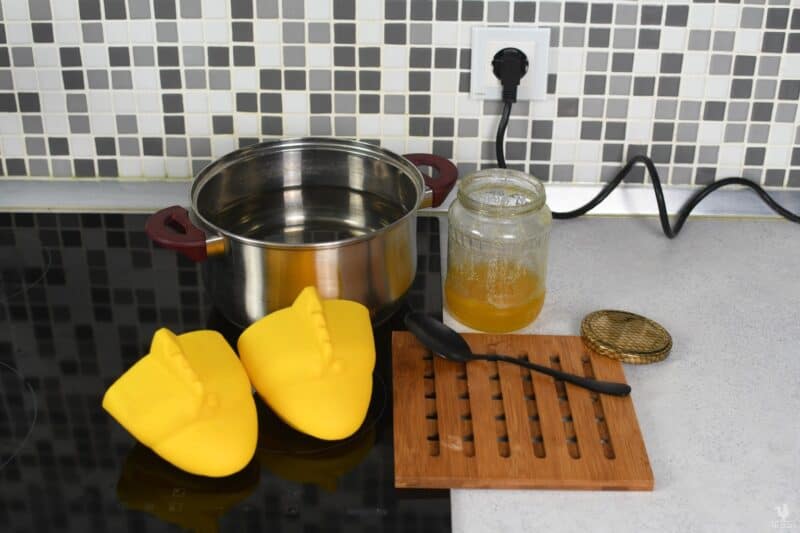
You’ve probably seen this before: your honey starts to look a little less clear and a lot cloudier, and then it gets that grainy, hard layer on top and before you know it it has a consistency almost like wet sand.
Definitely not that delicious, smooth texture we’re used to!
But is aggravating as this can be around breakfast time it doesn’t have to be a showstopper you don’t need to throw it out.
It is a snap to decrystallize honey using just a little bit of hot water. Keep reading and I’ll tell you how…
Table of Contents:
Why Does Honey Crystallize?
Before we get into the actual how-to on decrystallizing honey, you probably want to know why it crystallizes in the first place.
It is actually a basic reaction of the glucose already present in the honey bonding with moisture that is also present.
If you have more air space in your container of honey, it’s a lot more likely to happen and that’s why you usually see this occur in jars that have already been opened and used.
I should also point out that the more processed and filtered the honey is, the longer it takes for crystallization to occur.
If you have raw honey that still has a ton of pollen in it, it will crystallize faster than processed stuff that has been strained repeatedly for purity.
Is Your Honey Bad if it is Crystallizes?
No. Assuming the honey was good in the first place, meaning unfermented and uncontaminated, it is still completely safe to eat.
For clarity, it is totally safe to eat crystallized honey, although most folks don’t prefer it this way.
Likewise, once you decrystallize it using the methods I’m about to teach you, it’s totally safe and ready to be used again in the normal way.
What You’ll Need
No matter how much honey you have to decrystallize, and what kind of container it is in, you’ll only need a few basic tools to accomplish this.
Chances are you’ve already got all of them in your own kitchen.
Something to Heat Water
You’ll need hot water to do this, and possibly boiling water if your honey is in a glass container.
If the honey is in a plastic container you can use piping hot tap water. Otherwise you can use a microwave, tea kettle or your stovetop to get it good and hot or even boiling.
Container for Hot or Boiling Water
Any container you use for holding the water must be capable of withstanding significant heat, and if you’re going to use boiling water it has to be suitable for that.
Use your head and common sense, and make sure the container is safe and easy to handle even when it is full of hot water.
A container that deforms unexpectedly when it’s holding hot water might wind up burning you badly.
Trivet or Cutting Board
Being able to remove your container of hot water from the heat source and set it on the counter will make your life easier and the process safer. Use a suitable trivet or cutting board to hold your container.
Honey Container
Your honey is probably already in a container because it is crystallized. You can decrystallize it in a plastic or glass container, and the notable difference is that glass will withstand boiling water whereas plastic won’t.
Heat-proof Spoon
You’ll need to stir your honey during this process. Choose a spoon or other similar utensil that will fit inside the container holding the honey and also withstand heat.
Tongs or Oven Mitts
Especially if you’ll be handling a glass container that has been immersed in boiling water, you’ll need tongs or oven mitts that will protect your hands when it’s time to remove it if you aren’t going to let the water cool down fully prior to.
And that’s all you’ll need. Keep reading and we’ll get right to the steps…
Decrystallizing Honey in a Glass Container
If your honey is in a glass container you’ll have a lot more flexibility concerning the temperature of the water.
Glass won’t melt like plastic, though you generally need to get the water hotter to do a good job, and you’ll need to be cautious handling it when it’s finished. Do the following:
Step 1. Boil Water: Boil the water on your stovetop, in the microwave or in a tea kettle. If you aren’t using a saucepan on the stovetop, prepare your other container that will hold the water and your jar of honey.
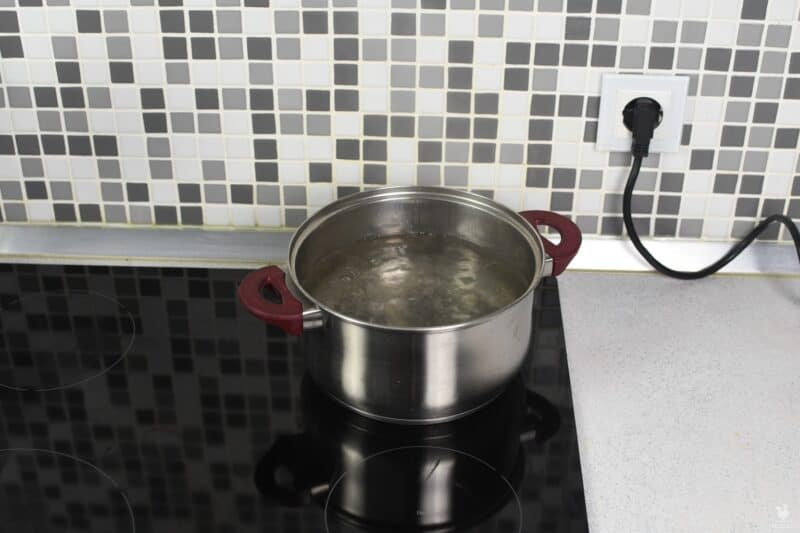
Step 2. Remove Water from Heat: Once it’s reached a rolling boil, remove your boiling water from the heat source and pour it into your separate water container if needed.
Step 3. Place Honey Container in Water: carefully place your open container of honey in the hot water.
Once more, be very cautious and pay attention that the displacement doesn’t fill the water to overflow into the honey.
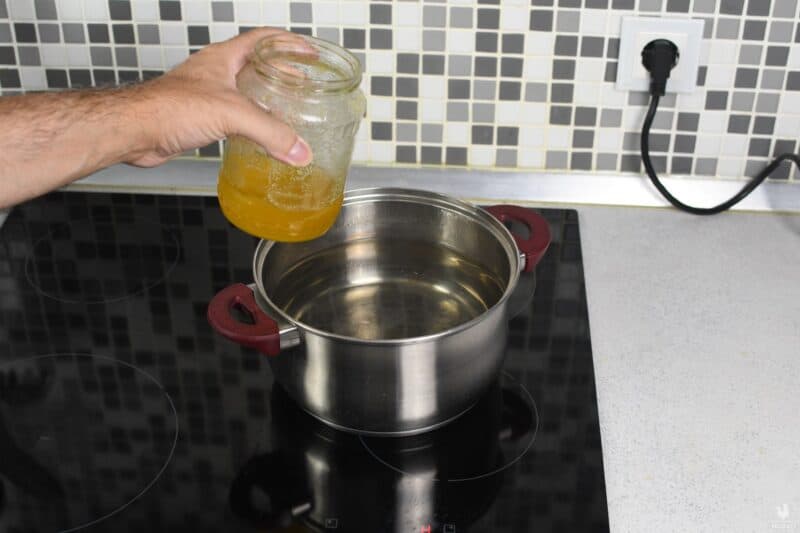
Step 4. Stir Honey: keep an eye on the honey and stir it regularly as it starts to decrystallize and liquefy.
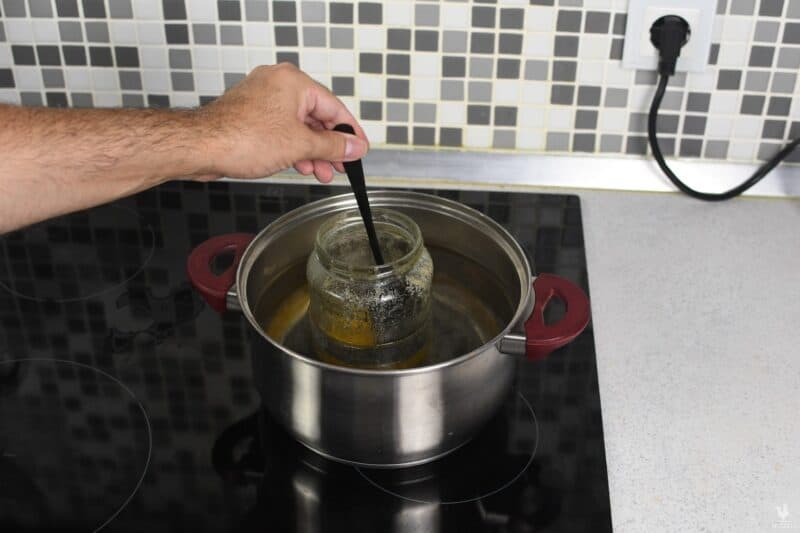
Step 5. Reheat Water as Needed: Boiled water will be able to go a lot farther before you need to reheat it again, but once it stops steaming, it’s probably time to add more boiling water. Keep it piping hot until the process is complete.
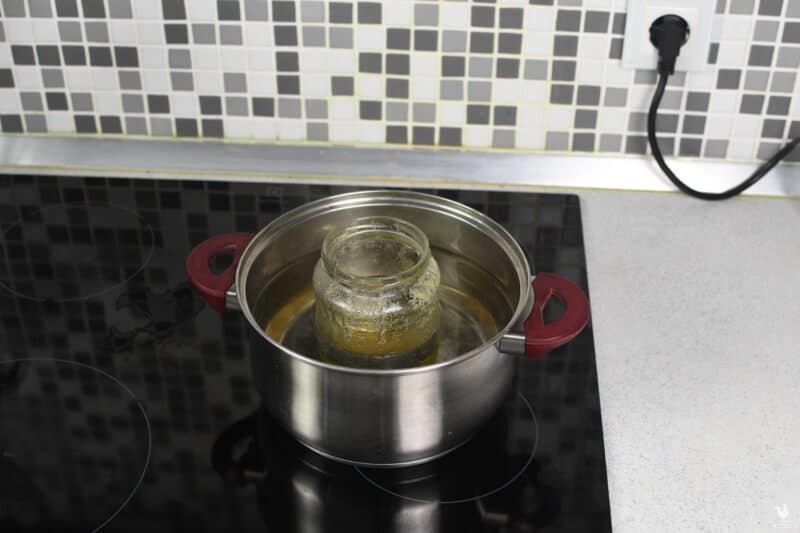
Step 6. Keep stirring and keep checking. Once your honey is completely smooth and translucent again, it is good to go.
Since you have a glass container, the process usually goes much faster, taking only around 20 minutes unless you have a very large jar to decrystallize.
Step 7. Remove Honey Container Carefully with Tongs/Mitts: bear in mind your jar of honey will probably be too hot to hold unless you let it cool down for a long time.
Cautiously remove it from the water using tongs or oven mitts and place it on a surface that won’t scorch. Loosely cover it, and then place the lid once it has cooled.
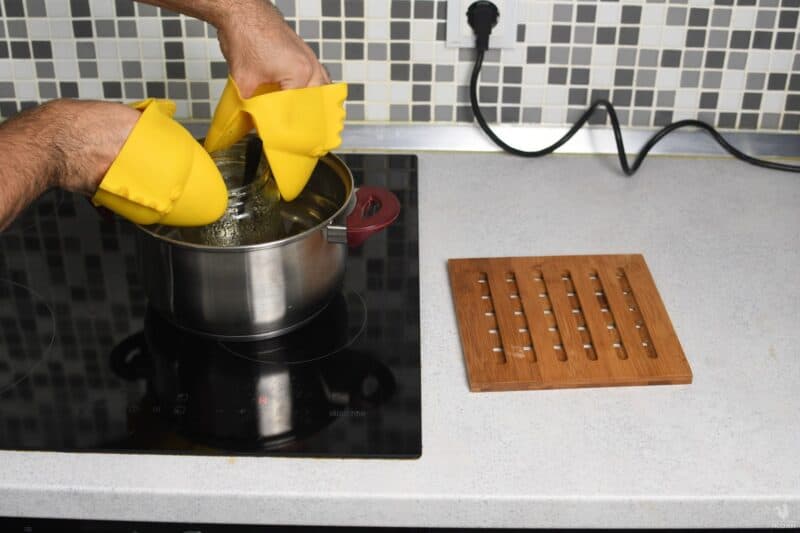
Once again, quite simple, though you’ll need to be more cautious when using a glass jar to prevent an accident from boiling water or breakage.
The the trade-off is that you can usually complete the process much quicker than you could with a plastic container.
This is what mine looked like at the end of the process:
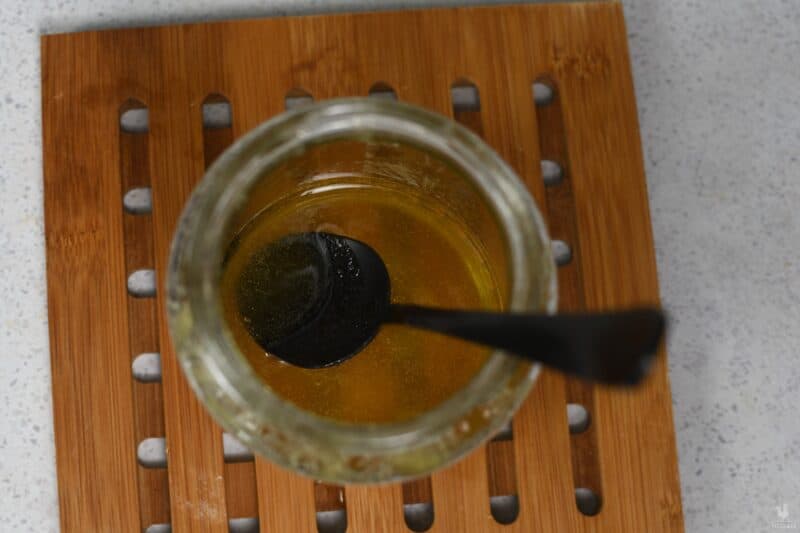
Decrystallizing Honey in a Plastic Container
If your honey is in a plastic container you only want to use hot water, never boiling water.
Boiling water will likely deform your plastic container or potentially destroy it, and even at best it’s likely to heat up the plastic enough that it will release chemicals into your honey, contaminating it.
If it’s in a plastic container, do the following:
Step 1. Heat Water: heat up your water. For plastic, a good rule of thumb is to heat it up no more than 140 °F (60 °C).
Any more than that and you risk compromising the container and potentially contaminating your honey. If you are in doubt, just use piping hot tap water.
Step 2. Open Honey Container: remove the lid from your container. This is to let the warming air out since condensation inside it can cause your honey to ferment later.
It also makes it possible to stir the honey and you don’t want to be handling the hot container anyway.
Step 3. Place Honey Container in Water: place your container of honey in your container holding the hot water.
Take care to not let the displacement of the water rise up over the opening in your container of honey.
Step 4. Weigh Down Honey Container (if needed): For plastic containers, if it’s mostly empty, it’s possible that it will float and top it over, letting water get to your honey.
You don’t want that to happen, so you can try weighing down the jar by leaving your spoon in it.
Step 5. Stir Honey: this will take some time, but keep an eye on your honey and watch as it starts to loosen up and liquefy once again. Stir the honey periodically to speed up the process.
Step 6. Reheat Water as Needed: your water won’t stay hot forever, obviously. Make a point to add fresh, hot water as it cools to keep the process underway.
If using hot tap water for honey in a plastic container, this will usually take around 30 minutes depending on how much honey you have.
Step 7. Honey is Done when Smooth and Flowing: keep stirring and checking the honey. When you notice that the consistency is totally smooth once again and your honey is flowing normally you are all done.
Remove the container of honey from the water, recap it, wipe it dry and you’re good to go.
And that’s all there is to it… I told you it was simple. Your honey is ready to use again, but you should try to eat it up before it crystallizes once more.
Useful Tips
- Do not directly heat the honey. This will not help things go any quicker, and is likely to ruin the quality of your honey due to scorching. Don’t put honey in a plastic container in the microwave, and don’t boil a glass container in a saucepan directly on the stovetop; direct heat from either is going to make things worse, not better, since you cannot control the temperature precisely.
- Be patient. Resist the urge to turn up the heat or add water directly to the honey to speed things up. Either will be ruinous. Stir the honey when you can, and keep the water temperature high and even. It won’t seem like much is happening, but then your honey will decrystallize and resolve seemingly all at once when it is warmed through.
- Decant your honey into a good glass jar. If you want to maximize the time that it takes for honey to crystallize, decant it from a plastic container or a cheaper glass jar into a glass container that has a tightly sealing lid. Glass is more resistant to temperature changes compared to plastic, and keeping moisture out of the honey will extend the time period before it crystallizes again.
Is it Possible to Decrystallize Honey in the Microwave?
Is it possible to microwave honey to decrystallize it and return it to its liquid state? Yes, and there are plenty of people that assert that it is the best method.
But, one of the worst things you can do to honey is scorch or boil it, because this will basically ruin it and it definitely change its texture and taste…
Accordingly, you need to be careful using this method. And even so, if you’re really in a rush to get your honey flowing again the microwave works in a pinch. Here’s how:
Step 1. Transfer crystallized honey to a microwave safe bowl. Don’t leave it in the bottle or container. I used a small ceramics plate and just a little bit of honey for demo purposes:
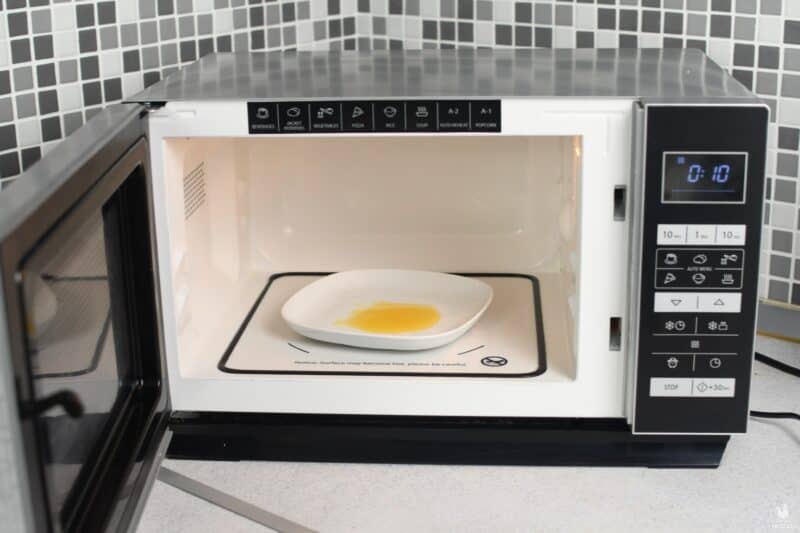
Step 2. Adjust microwave power to 50%, possibly less. Microwaves are notoriously finicky and fussy when it comes to precisely controlling the heat that is applied to your food.
Running your microwave on full power for even a few seconds is likely to harm your honey.
Step 3. Heat honey on low-power for 10 to 30 seconds. This depends on the quantity you are trying to decrystallize. Smaller quantities that need a shorter duration in the microwave.
I set mine to only 10 seconds since I saved a little bit after using the boiling water method:
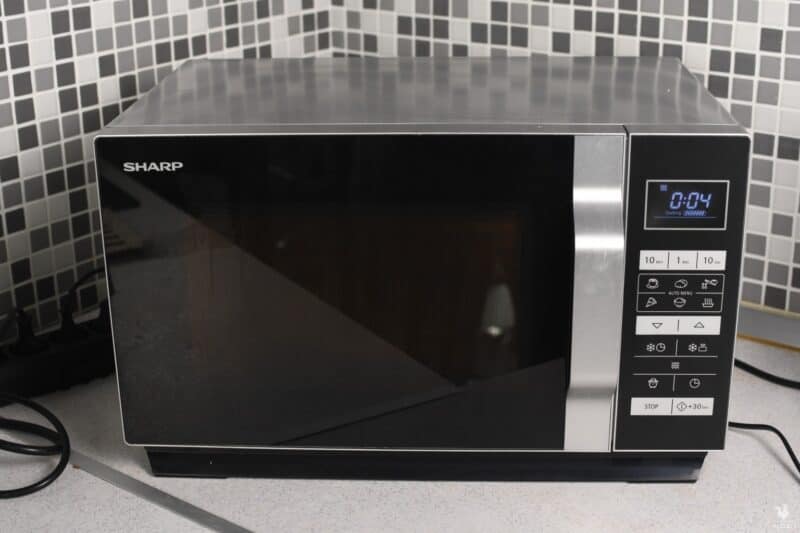
Step 4. Stir. Give it your honey a brisk stir and watch for any signs that it is getting too warm. If it is still cool and crystallized, give it another 10 to 30 seconds on low power.
Step 5. Repeat until the honey is liquid and flowing again. Once the honey is flowing smoothly, you are done. Remove it and handle it carefully so you don’t get burned.
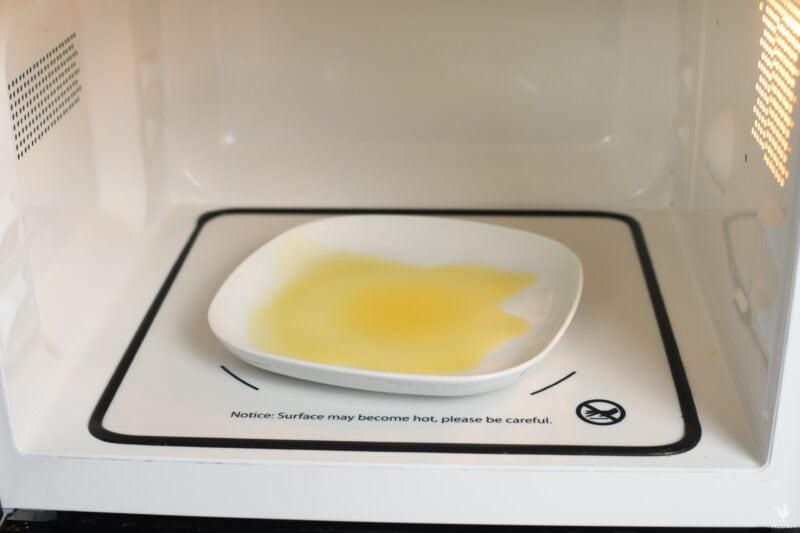
If you need your honey ready to drizzle right this moment, the microwave is your best option. but it comes with a serious drawback…
In my experience, when you heat your honey in the microwave it will curiously start to recrystallize quickly after it cools back down.
I’m not sure why it happens with microwave heat and not with heating it through gently via water like I detailed above, but it is a known phenomenon.
Of course, you can reheat the honey once again to make it liquid, but I have serious concerns about what this will do to the quality and longevity of the honey itself.
How Many Times Can You Safely Decrystallize Your Honey?
You can decrystallize honey at least once and expect the quality to be very good. Most of the time, you can decrystallize it twice, but any more than that and you will start to notice the honey being a little bit off.
This is because continual crystallization and decrystallization of the glucose in the honey will start to permanently change the texture.
Also, there is some evidence that repeated exposure to elevated temperatures does affect the enzymes and antimicrobial properties of honey, so that’s something else to keep in mind.

Tom has lived and worked on farms and homesteads from the Carolinas to Kentucky and beyond. He is passionate about helping people prepare for tough times by embracing lifestyles of self-sufficiency.
